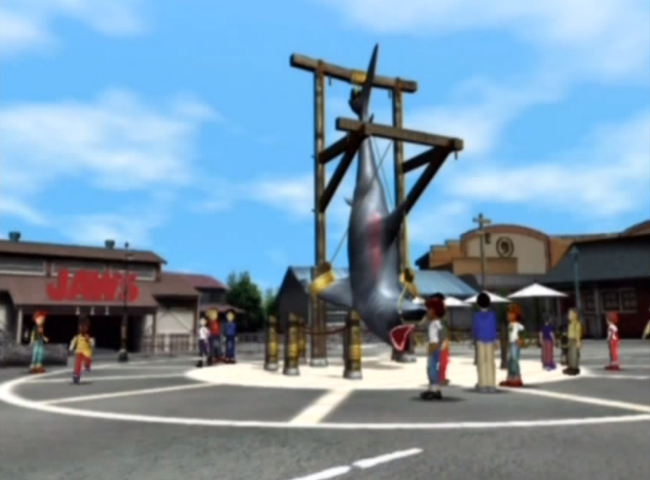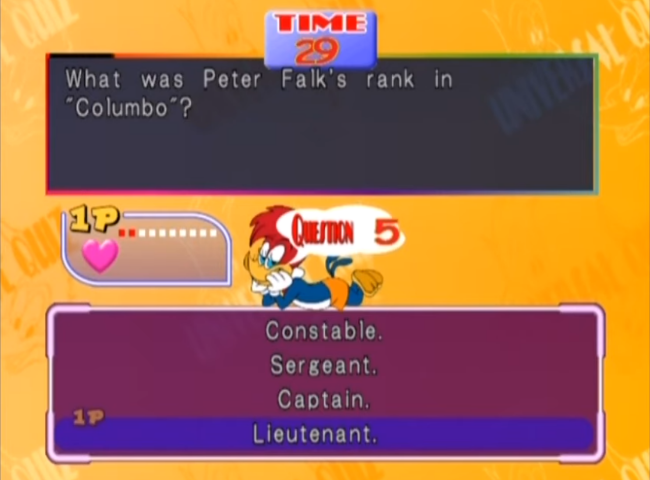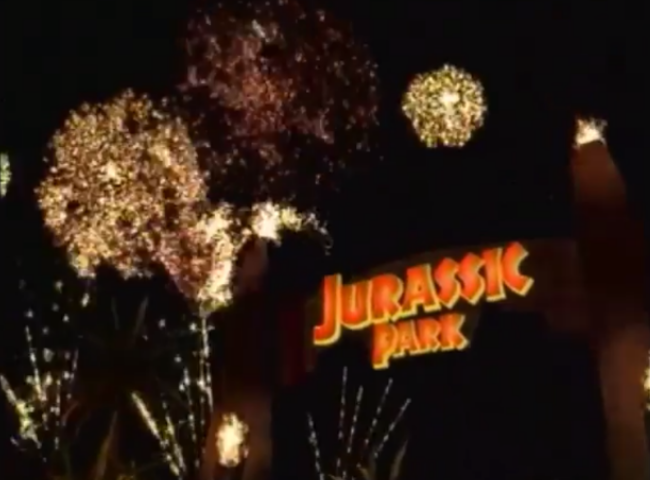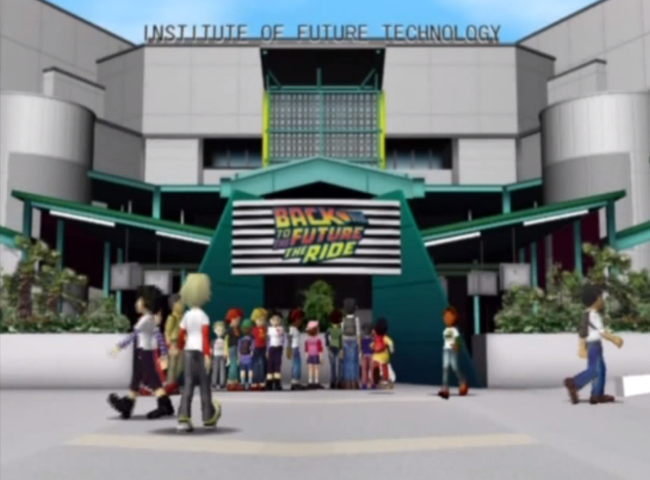Jaws takes about three minutes to beat and, once the timing is figured out, is impossible to lose. Pick up one of those famous yellow barrels, circle the deck of the Orca until radar gives away what side of the boat the shark will attack, and heave just before impact. Rinse. Repeat. The John Williams score deserves better.

E.T. Adventure is a better use of John Williams, but not by much. NES veterans will recognize it as Excitebike with a significantly slower bike that stops dead and falls over after every jump. The obligatory moon shot is present and accounted for, but players never get to control the bicycle as it flies. The rewrites on this one, including Raiders of the Lost Ark boulders and massive landslides, aren’t nearly as exciting as E.T.’s home planet, which is left to the actual theme park attractions.
Animation Celebration is there in name only. The attraction, which let Woody Woodpecker bother his animator through the miracle of Holovision technology, was a one-of-a-kind experience in the Universal tradition, showing how another kind of cinematic sausage is made. The mini-game is just obscure trivia about the Universal DVD catalog. Some of the questions are funny now - they left open the possibility of Back to the Future Part IV by asking how many there were as of 2001 - but most have gotten significantly more difficult in the decades since. If you don’t have a working knowledge of Sneakers lore, good luck.

Waterworld is another faithful translation, but at least Back to the Future: The Ride was an interactive experience. Here, players are given the choice of a few different seats from which to enjoy the pre-rendered finale of the stunt show. The seaplane crashes over the wall. Switch seats. The seaplane crashes over the wall. Switch seats. The seaplane crashes over the wall. Extra points are awarded each time. It also closes at dusk, so go early if you really want to see it.
Universal Studios Theme Parks Adventure has a strange relationship with realism. Waterworld closes. After your first ride of the day, all other attractions have lines long enough to necessitate paying for a shortcut. In the real world, it’s an Express pass. In the digital world, it’s a unique hat for each attraction. They can only be bought with points earned from doing well on the mini-games, which eventually can only be played with hats, which can only be bought with points earned from doing well on the mini-games, and so on. When players grind enough to afford the next hat, they then have to hike all the way back out of the park to see Woody Woodpecker by the Universal globe. Lines get longer and trash can be picked up off the sidewalks, but there is no way to spend money inside this virtual theme park.

The map might be the most telling disconnect of all. As stated, it's clearly Universal Studios Japan. A little blinking dot even tells the player where they are. But the park proper is broken up into static angles like an early Resident Evil game. No two angles follow the same compass. Exiting one screen to the right might mean entering the next from the same direction, catching players in a momentary infinity loop of circling back and forth between screens if they’re still holding the stick. If the map says an attraction is up and left, the only way to get there may be straight down. One necessary path away from Mel’s Drive-In is borderline subliminal. Finding all the hidden letters in “UNIVERSAL STUDIOS” on the ground - the only requirement to beat the game that doesn't involve a mini-game - might as well be an eye test. If two pixels seem like the wrong color, they’re probably a letter. Good luck on the first “I” in Universal - it’s two screens deep in a direction players have no reason to believe exists.
And what’s the grand finale? The Hollywood Magic fireworks show. Some of the pre-rendered environments briefly reappear in actual 3-D. Big-headed mascot versions of some Universal monsters, that players may or may not ever see during the actual game, watch in awe. But considering the actual extravaganza at Universal Studios Japan exceeded the legal limit of allowable explosives by about 8 pounds nightly, it’s a fizzling disappointment.

When I dug out my copy, one of two GameCube games I unwrapped with the system some years after launch, it took me about an hour-and-a-half to beat Universal Studios Theme Parks Adventure. I could’ve taken longer to get the high-score red stamp in each mini-game as opposed to the good-enough blue, but I felt no obligation. The nostalgia was enough.
These days, Universal Studios Theme Parks Adventure regularly makes respectable appearances on Worst-Of lists. It achieved bad game immortality with a personal skewering from The Angry Video Game Nerd. Copies can be found on Ebay for about $15, give or take. It’s worth noting that the Japanese version - Universal Studios Japan Adventure - tends to run higher. The game was so successful in its home country that Welcome to Universal Studios Japan, a pseudo-remake, hit the PlayStation 2 in 2003, boasting a fully rendered and roamable park populated with entirely new mini-games.
Though it excludes the properties Universal Studios Japan only licensed, like Spider-Man and Snoopy, the game lives on as a strange time capsule. Of the represented attractions, only Jurassic Park, Backdraft, Jaws, and Waterworld live on, two of them as the last versions standing anywhere in the world. When the game was first released, the Vivendi Universal merger was barely a year old. Universal Orlando’s brief rebranding to Universal Studios Escape had done more harm than good and the bill for Islands of Adventure’s oversold attendance was coming due. The following decade would be the most tenuous in Universal parks history.

But before all that, for approximately 90 minutes, you could play the best of them in your own living room. It was too short for the T-for-Teen crowd the ESRB allowed and too hard for the younger players it was so clearly designed for. Disney parks have gotten their own mini-game collections before and since. For Universal fans, though, this game offered as much ambiance as the company could legally allow and the Nintendo GameCube could reasonably render. Good, bad, or borderline broken, especially in a pre-YouTube world, that’s a tough ticket to pass up.

Add new comment